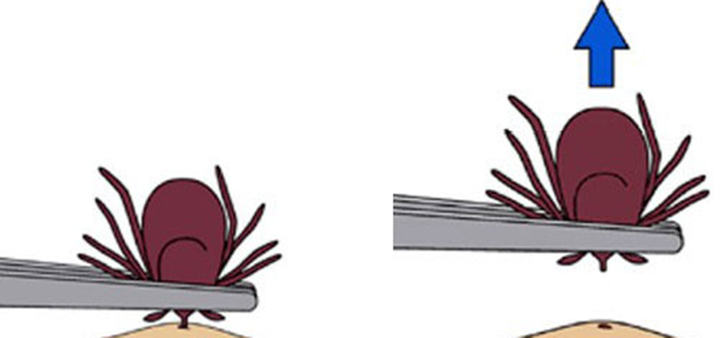Health Department Offers Tips To Stay Safe This Tick Season
Published:
April 24th, 2023
By:
Sarah Genter
 If a tick is found on an individual or pet, it is recommended to remove the tick using tweezers and constant force. Using irritating methods such as soldering irons, lighters, and essential oils encourage the tick to back out on its own, which can increase the risk of Lyme disease. (Photo from the CDC)
If a tick is found on an individual or pet, it is recommended to remove the tick using tweezers and constant force. Using irritating methods such as soldering irons, lighters, and essential oils encourage the tick to back out on its own, which can increase the risk of Lyme disease. (Photo from the CDC)
CHENANGO COUNTY — Although tick exposure can happen year-round, ticks are most active from April to September, making exposure to ticks and tickborne illnesses more likely. The Chenango County Health Department encourages area residents to take preventative measures and practice diligence to prevent disease.
Chenango County Public Health Director Isaiah Sutton said although ticks are most commonly found in tall grass, such as meadows and woodlands, they can be present in any grass, leaf litter, or mulch — meaning individuals should protect themselves whether they're going into the woods for a hike, or spending time in their own backyard.
"Any time you’re in the grass or outside, it's a good idea to check yourself when you come back in," he said.
"The best way to prevent a tickborne illness infection is to use primary precautions: Wear long pants if you’re going out in the woods or if you’re going to be working in a long meadow. You can spray your pant legs and your boots with an appropriate pesticide like permethrin, which is pretty effective at repelling ticks," Sutton continued. "Even if you follow those practices, when you return home, as soon as practical, take your clothes off, take a look, check yourself when you shower that evening or in the morning. Make sure you’re checking yourself for bumps that you didn’t have yesterday."
The Center for Disease Control (CDC) said clothing and gear can be treated with products containing 0.5 percent permethrin, which will keep items protected through several washes. Clothing and gear can also be purchased pre-treated with permethrin.
Additionally, the CDC warns that ticks can be carried into the home on clothing. To kill ticks on dry clothing, they recommended tumble drying clothes in a dryer for ten minutes on high heat. Additional time may be needed for damp or wet clothes.
When checking for ticks, Sutton said to pay attention to areas of the body with soft skin, such as the insides of the legs, armpits, around the ears, and in the base of hair. The CDC said individuals should also check inside ears, in bellybuttons, between the legs, and around the waist for ticks.
Should an individual find a tick on themselves or a pet, Sutton said to remove it with a pair of tweezers "using constant negative pressure," and disinfect with an antiseptic afterward.
"You want to pull it out as fully and completely as possible, getting just as much of the head as possible. If this isn’t something you can do for yourself or with the help of a family member, we encourage reaching out to your primary care provider or a local walk in to help you with that," said Sutton.
He also advised against using things like hot soldering irons, lighters, and essential oils to remove ticks, as getting the tick to back out of the skin on its own can actually increase the risk of Lyme disease.
"We don't encourage that because what that does is it irritates the animal to back out on its own, and when they back out on their own is when they excrete the Lyme disease spirochete, or the bacteria that causes Lyme disease. They only excrete that while they’re backing out themselves. They’re much less likely to excrete that Lyme disease if they’re pulled out forcefully," Sutton explained.
According to Sutton, black-legged ticks, also known as deer ticks, are the most common carriers of Lyme disease, and are commonly found in Chenango County.
He recommends a visit to a primary care provider for any tick bite in which the tick has been embedded for longer than 12 hours, but also if individuals find a red, ring-shaped or bullseye rash. The rash is an indicator of impending Lyme disease infection.
"If you believe it’s been on you for an excess of 12 hours, we encourage you to reach out to your provider. They may want to start you on a preventative course of antibiotic," said Sutton. "If there is rash in the area, or you identify a ring rash around a bite mark that you didn’t have before, we definitely encourage you to reach out to your provider."
However, he said not all individuals bitten by a tick carrying Lyme disease will develop a bullseye rash, and there are other diseases that can be transmitted by ticks without causing a rash.
"Ticks can carry a whole host of diseases, from babesiosis, anaplasmosis, and Rocky Mountain spotted fever. There’s a number of diseases that ticks carry. We are really just starting to see those last three locally. They’re fairly uncommon. Not unheard of, but relatively uncommon in our area at this point, but we seem to think that that number is rising," he said. "As the prevalence of ticks increases —whether that be from climate change or travel, or any number of reasons — we are seeing more ticks than we have in the past, and with that we see more of these diseases."
He advised those that opt not to visit their doctor after a tick encounter to write down the date of exposure, in case they get sick later.
"A good course of action if you have a tick encounter and you decide not to see your provider immediately, make note somewhere that 'oh jeez, on this day I had a tick,' so that in the coming weeks if you become ill, you can also share that with a doctor to make sure they're testing for those tickborne illnesses sooner than later. Sometimes the tickborne illnesses go unreported. You don't think about it and then you get sick, and you don’t always associate the two things," Sutton explained.
Some symptoms to watch for include chronic fatigue, malaise, joint and body aches, and a general feeling of being sick or run down, which are all indicative of Lyme disease.
Individuals who would like recommendations on what to do if they discover a tick, coaching to help them remove it, assistance identifying tick species, or to get a tick removal kit can contact the Chenango County Health Department at 607-337-1660.
More information on tick bite prevention and safety can be found at www.cdc.gov/ticks/avoid/.
Author: Sarah Genter - More From This Author
Comments








